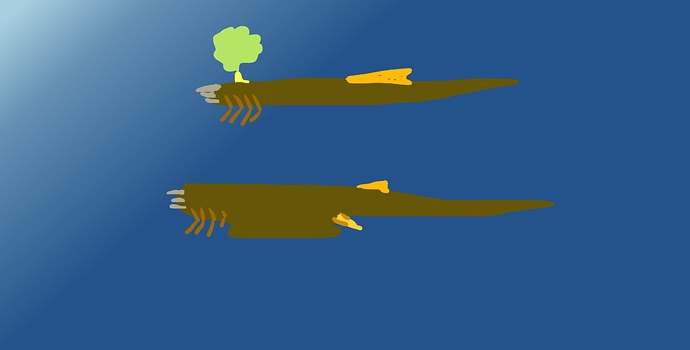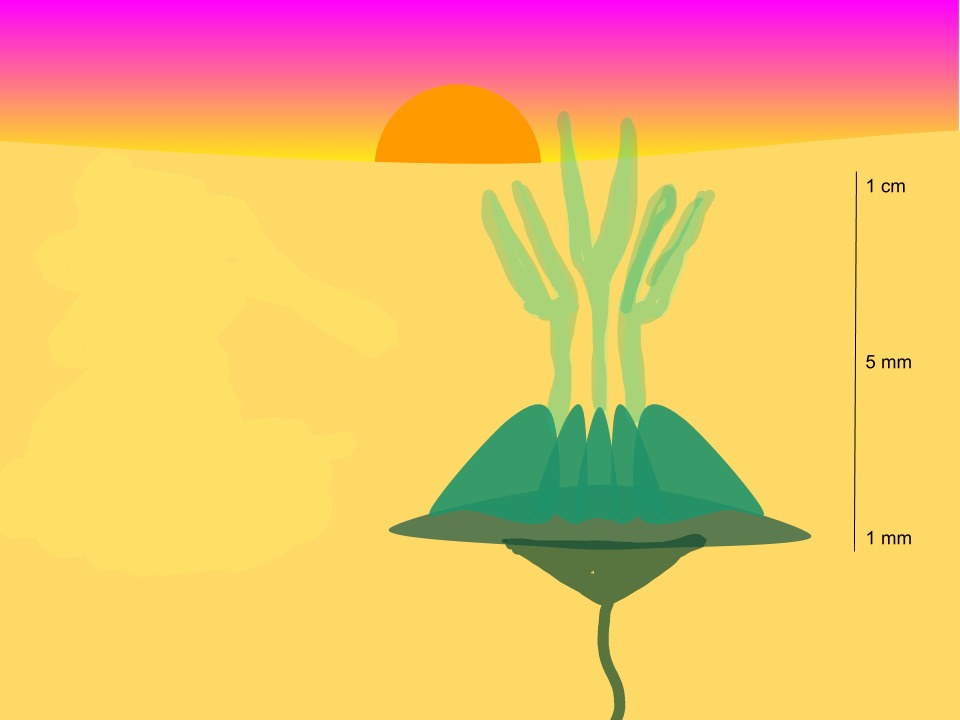I fixed it all…
Looks lovely now! I’ll be updating soon for sure!
We have gotten far, haven’t we. 100 posts. As if celebrating this momentous occasion, the sun which Kakhitt orbits around, a nicely sized star, not dissimilar to our sun, flares up, releasing tons of UV rays. These hit the creatures of Kakhitt. While not enough to kill them off, this has caused changes in much of the genetic material. Creatures are born malformed, and die. However, some creatures are born with beneficial mutations, and give rise to new species. Evolution occurs, creatures died off, and more and more are developing fleshy little tabs on their bodies. However, the Surav worm body shape remains pretty similar to usual. Perhaps it’s time for a little…modification on their part. However, remember the colonization of land? The Iomubae Horta Amphabis has undergone a few mutations. First off, the ones with the hardest membranes survived the scorching heat of the land, leaving them with shells and fork-like proto-leaves sticking out of them. The hard bottom stores food supplies centralized for the plant, so it is a great desert plant, and the forks of the plants have become longer and wider so as to soak up more of the sun.
Both plants stand self-assured at their height of 1 cm, but the Teris is the first truly land plant. However, it needs to specialize. So, the Teris population begins to evolve, covering Kakhitt in different sorts of plants. Rapid evolution is occuring, and you don’t want to be left out.
Alright, so welcome to new members, and welcome back to older ones! The first land plant has just been created,but in order to truly thrive, it needs to specialize. So, I am making a completely new system that I will update, although it will only be shown when we all vote to move to land completely. This will be a food web, and there will be different ones depending on the biomes. However, so far, the only biome in which life exists on land are:
The Hortebeaches: These beaches are filled with both amphibious and terrestrial plants, although the terrestrial Horta are winning. Soon, these plants will spread all over the world, although most likely in different forms.
In this new race on land, you must remember that specializing and focusing into one niche is key. If you don’t, that will go extinct. Life will continue underwater as usual. Use your imagination as well, but don’t go too overboard.
Forgot to mention, this is the map of Kakhitt!
The orange area is where the Surav worms and Arruptiors live, so they’re in good shape for land. The Horbeaches exist wherever there is an outline, as the Amphabis was on all four continents, and the Teris as well. But, it is time to name them! The leftmost continent is called Goteara, the middle is called Thuneera, the biggest is Smahoufenova, and the smallest is Burgeblasea.
Please sorry for question, but by Arruptors Miscericors evolved Arruptors Sigma, aren’t they? Or that evolution was small to appearing of new species?
New species: Ophipoda plumomorphus
Old species: Excogitatoris microterra
Changes: Ophipoda’s development has changed, leading to the surface layer being made entirely of appendage-bearing modules. This leads to its entire body being covered in fleshy fins, 17 pairs in total. Its eyes are larger, and between the 2nd and 3rd limbs. Also, each appendage develops 5 times end to end, leading to increased length. It has moved to the littoral zone, and can survive out of water for a short time, using its many limbs to crawl between pools. It can slightly retract its limbs into its body, to aid in moving between rocks. The larvae are herbivores, eating whatever plant parts it can find, but the adults are omnivores, feeding on plants, but also on the offspring of other ophipods
A rough image, adjacent limbs are actually quite close in angle from body, and the body is tapered and slim
New Species: Mobilius Pachei
Old Species: Mobilius Pachei
Changes: Pachei’s side fins have become strong enough to pull itself on land. It can’t breathe yet, but Pachei has evolved leathery skin to withstand the heat.
Behavior: Pachei climb out of water while waiting to hunt and to eat the Horte plant.
No visual changes
New Species: Mobilius Herbus
Old Species: Mobilius Herbus
Changes: Herbus has exploded in size because of the gamma radiation. It is now about 12 cm.
Behavior: Nothing Different
No visual changes
Sorry, forgot to change the name 
Burgeon, nice evolution! However, if it’s not too much trouble, can you make a picture of it? The large amount of fins seems important enough to be drawn. If it’s not possible, I can make a visual representation of it. Just let me know!
And more question, why parasites are dying? I want know the reason🙂
Now i’m back! yay!
new species: grevapoda
old species: grevacodia predatorus
changes: grevapoda’s grevacods became longer, helping it reach objects from a farther distance, it also uses them to walk on the seafloor.

new species: grevacodia oculus
old species: grevacodia dublises
changes: dublises grew a second pair of grevacods, helping it grab things better and holding them tighter.

I’ve added an image and explained their diet
New species: lovag
Old species: mharacoltach fljótur
Changes: lovag has evolved some more hard skin a bit mineralised
New species: páncélozott
Old species: chaneilinbheach ovum
Changes: páncélozott has evolved mote hard skin which is a bit mineralised and also has been going more near land.
New species: tüskésfej
Old species: excogitatoris accelerato
Changes: tüskésfej has evolved a more spiked skull abd the eyes have moved more infront. And also has evolved gills in front of the spikes and also back so the water flows with oxygen
The solar flare’s effects have died down to a normal level now. Many new species have come about from this, and many species have hardened themselves, adding mineralized shells to their bodies. The grevacods, a clade that had not evolved for many a millenia, have changed because of this solar flare. Other species are beginning to go to land. One particular population of Gibbus Mineas Commus was hit hard by the solar flare, so hard that their offspring were changing, and in drastic ways. One, the appendages on which their teeth rested grew farther and developed more muscle until it became a proper jaw. The teeth were also replicated on the bottom of their legs (which had also become stronger) making a sort of claw. They have also gained an eyespot, similar to how many species prior gained them. However, the biggest evolution that occured is the regaining of their Hakis. An organ that was suppressed in the worker class of this species, it has returned, albeit in a different place. These creatures prey on other animals using their pack instincts (which come from their ancestors colonial behavior) and their newfound jaws.
One animal that has had to compete with these is the Pachei, and because of the jaw, it soon finds itself out-competed. However, there is a place for it to hide. With the development of leathery skin, a few Pachei soon find themselves land-bound, on the Horbeaches of Gotorea. Nearby, a large adult Ophipoda crawls onto land. There isn’t much good food to graze in the shallows, and so, to find some food, it begins to journey upwards. Ophipoda are also found on the western coasts of Smahoufenova, and they abound on the shores of Thuneera. The Mineas Sehakisus (the predatory Commus) are also on Thuneera and Smahoufenova, but none are on Gotorea, luckily enough for the Pachei in that area. None of these are terrestrial though, they are at the most, amphibious. However, the Horta continues to spread inwards. None of them have changed, interestingly enough. But, soon, some may.
Alright, that was definitely a fun round! Interesting changes, all of you! Soon, we will have to vote if we focus on land or the sea. I can’t handle both, so unfortunately, we will have to focus on only one. The species application sheet is also getting revamped so as to fit the food webs better. The current food webs can be found on the Discord. Off for now, but I’ll see you all next time!
New species: Ophipoda pulmocaudi
Old species: Ophipoda plumomorphus
Changes: Driven by the species’s infanticidal canabalism and fast reproduction, pulmocaudi has evolved quickly. It has 2 pairs of forked antennae before the eyes, and a third pair on the tail. The most notable change to the tail is that it has lost the bones. The limbs are also lost, except for the pits of the limbs at the ends of the tail. These allow air into the tubular remains of the spinal column, forming a primitive crocodilic lung. The tail can pump in order to breathe. The remaining limbs gain ossified bones, and fork into 3 at the final region, giving the species 6 pairs of 4-part 3-toed limbs. They also have paired marsupia/wombs formed from the retraction cups of limbs, which combined with the cloaca. Their skin is thicker and more resistant to drying. It has also increased in size, to about 10cm.
New Species: Respa
Old Species: Mobilius Pachei
Changes: Respa has evolved small lungs, that help it stay above water for longer periods of time. Their fins have become more like fingers and are better at pulling across the barren wasteland. They also have grown to be about 3 cm on average.
Behavior: Pachei Dig holes about a foot deep on the shores, in which they lay their eggs. When they grow up, the offspring climb into the water to start hunting and feeding immediately. Also, in larger groups, Pachei begin hunting the ophipoda.
New Species: Hebus Bifuyes
Old Species: Mobilius Herbus
Changes: Bifuyes has evolved thicker skin and has changed to a greenish color, which helps with attracting mates
Behavior: The greenr a Bifuyes’s skin, the more likely a mate will mate with them.
New Species: Commus Sovis
Old Species: Gibbus Mineas Commus
Changes: Sovis workers have evolved a small chemical that was derived from their pheromones that has an effect on other suravs.
Behavior: they use the chemical to trick the Sehakisus into giving them food.
Where does Respa live? because O. pulmocaudi generally stays out of water, due to the thickened oxygen-proof skin and lack of gills
New Species: Iomubae Teris Dexus
Old Species: Iomubae Hortis Teris
Changes: Dexus has evolved a long, strw like root that reaches far down to get water.
Behavior: This allows Dexus to move farther inland without fear of not having water.
Respa Lives both in and out of water
Burgeon, you need to make a picture for the Pulmocaudi. I love the description and I can visualize it, but as per the rule, you need to make a picture. Of course, as always, I can make a picture based off the description and old picture if you don’t have time or anything. Just let me know! But remember that you need to make a picture for the organism (i’ve rehashed this too many times in this post alone  ).
).
I added the Image…
I, of course, understand, here simple game, but have Iomubae Teris Dexus conductive fabric? Or how that names?)















